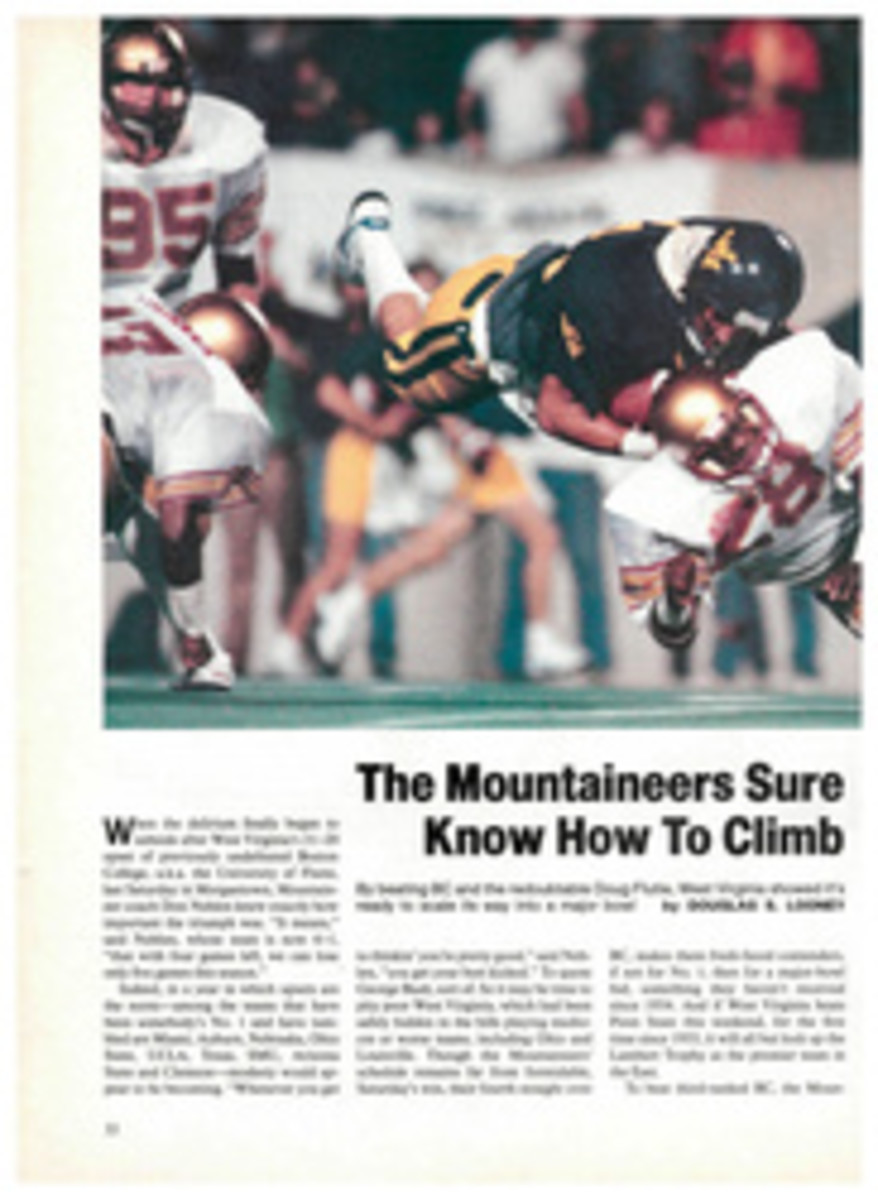
SCORECARD
A BASS ACKWARDS ATTEMPT TO SAVE THE STRIPER
In the last decade, the catch of striped bass, the premier game and food fish of the Atlantic Coast, has dropped by a catastrophic 90%.
Now in a weak attempt to save what's left, President Reagan this week is expected to sign into law the Atlantic Striped Bass Conservation Act, which mandates a 55% reduction in the catch from North Carolina to Maine by July 1 of next year. The bill, which was introduced by Representative Gerry Studds (D., Mass.), also authorizes the Secretary of Commerce to impose a moratorium on striped-bass fishing in the waters of any state that does not comply with the 55% reduction.
The bill is better than nothing, but it has its flaws. In fact, it got through the Senate only after minority leader Robert Byrd, a Democrat from the coal-producing state of West Virginia, threatened to kill it unless an amendment requiring that particular attention be given to the effect of acid rain on striped bass be deleted. The bill falls far short of the moratoriums called for by Representative Claudine Schneider (R., R.I.) and Senator John Chafee (R., R.I.), who was responsible for the $5 million Emergency Striped Bass Study authorized in 1979. It also doesn't pack the wallop of Maryland's September announcement of a moratorium on striper fishing in that state as of Jan. 1. In giving reasons for the ban, Secretary Torrey C. Brown of the Maryland Department of Natural Resources cited "recent studies on acid rain, bioassays on fish eggs and larvae, measurement of brood stock size and spawning success and, most important, the Maryland young-of-the-year index," which indicates spawning success or failure. This year, the index was a dismal 4.2, and Brown said that the moratorium will last until the index is at least 8.0 for three consecutive years.
Not long ago, this magazine offered the hypothesis that acid rain is significantly responsible for the low rates of survival of striped-bass larvae and those of six other fish species in poorly buffered tributaries of Chesapeake Bay (SI, April 23). Acid rain can impart an acid pulse to a body of water that has little total alkalinity or buffering capacity. Acidity is measured on the pH scale, which runs from acidic on the low end to alkaline at the high. A pH of 7 is neutral. Research has shown that larval striped bass do best in alkaline water and have difficulty tolerating pH levels of less than 7. New field and laboratory research sponsored by the U.S. Fish and Wildlife Service strengthens that hypothesis.
Last April, aquatic toxicologist Lenwood Hall of Johns Hopkins headed a team that found that larval striped bass placed in the Nanticoke River on the Eastern Shore of the Chesapeake suffered excessive mortality rates. A total of 3,000 day-old larval stripers were put in six chambers set at three different stations in the spawning reach of the Nanticoke. Automatic samplers took water from the river every 15 minutes, and composite samples from each 24-hour period were preserved so that they could be analyzed for dissolved aluminum and other contaminants that can be mobilized by acidity.
After four days in the river, more than 90% of the larval striped bass were dead, while control larvae kept in clean alkaline water in tanks on shore had a 25% mortality. The experiment was repeated with similar results. "The factors we feel are responsible are low pHs—approximately 6.3—high aluminum concentrations and very soft fresh water [indicating little buffering capacity]," Hall says.
Meanwhile at the National Fisheries Research Laboratory in Columbia, Mo., Dr. Paul Mehrle supervised a series of bioassays and found that 10-day-old bass suffered 100% mortality in water with a pH of 5.5. At pH 6.5 with 100 micrograms per liter of aluminum added to the test water, mortality was 85%.
With acidification apparently triggering the decline in Chesapeake stripers, the well-buffered Hudson River remains the only major reliable source of supply on the East Coast. Although the Atlantic Striped Bass Conservation Act notes that habitat loss has contributed to the reduction of striped bass, it doesn't mandate habitat protection, a deplorable omission.
In support of Westway, a massive highway-real-estate project proposed for lower Manhattan, Governor Mario Cuomo of New York wants a permit from the U.S. Army Corps of Engineers to fill in more than 200 acres of the Hudson that serve as vital nursery grounds for young striped bass.
If those acres are filled, the federal government will pay 90% of the project's estimated $4 billion cost, while the river may lose 30% to 60% of its stripers. It makes no sense at all to pass a bill piously calling for conservation of striped bass and at the same time provide federal funding for a project that would torpedo Noah's ark.
—ROBERT H. BOYLE
ON SCHEDULE
To nobody's surprise, Lou Saban quit last week as football coach at the University of Central Florida in Orlando. Saban, 63, is unquestionably the world-record holder (sports division) for changing jobs, having had 18 of them in 34 years. When he took a powder at Central Florida with 10 months to go on his contract, he mumbled something about "lack of support by the administration," and he also somehow blamed his problems on the athletic department's having no full-time academic adviser. Some folks at Central Florida think that Saban, whose team was 5-6 last year and is 2-6 so far this season, walked because he thought he was going to be fired. That may be true. But mostly he walked because he always walks.
For the record, before he landed at Central Florida, Saban had been coach at Case Institute, an assistant at Washington, an assistant at Northwestern, head coach at Northwestern, an insurance salesman in Chicago, coach at Western Illinois, coach of the Boston Patriots, scout for the Buffalo Bills, coach of the Bills, coach at Maryland, coach of the Denver Broncos, general manager of the Broncos, coach of the Bills (again), athletic director at the University of Cincinnati (for 19 days), coach and athletic director at Miami, coach at Army, executive assistant at Tampa Downs and the New York Yankees' president.
As that list suggests, Saban's ability to keep coming up with new coaching jobs is pretty amazing for a guy who has been a loser both in the college ranks (52-66-4) and the pros (96-102-7). Last year in a feature story on Saban, SI senior writer Douglas S. Looney noted that at the time Saban took the Central Florida position, he'd averaged 1.8333 years at each of his previous jobs. He was just about on schedule at Central Florida, where he lasted 1.7972 years.
DIMINISHING RETURNS
Woody Woodward, assistant general manager of the Cincinnati Reds, feels that baseball may be hard-pressed in the future to find people with big league experience who are willing to stay on in the game as managers, coaches and instructors. Top stars have shown little interest in recent years in becoming managers (Pete Rose of the Reds is a notable exception), particularly in the traditional training ground of the minor leagues. Now, says Woodward, that attitude is becoming evident among lesser players, too. It's from this group—those who have had to battle their way in the game, using hard-won knowledge to augment their skills—that the best managers have often come (the World Series skippers, Sparky Anderson of the Tigers and Dick Williams of the Padres, are prime examples). A number of such players have always looked upon baseball as a lifetime career, something to stay with after their playing days are over. That is no longer the case.
"Take a look at the financial packages given to players of lower quality," Woodward says. "The multiyear deals, the big money. If they invest correctly, these players aren't going to have to worry a great deal about making a living after they finish playing." The standard of living they have been used to as major-leaguers makes the modest salaries and Spartan life in the minors distinctly unappealing.
Woodward mentions two of the Reds' best minor league instructors, Ted Kluszewski and Danny Litwhiler, whose major league careers ended long before the dawn of ultrahigh salaries. "Down the road," Woodward says, "I don't think we'll be able to keep this type of person in the game."
Unless, of course, the owners break down and raise the salaries of managers, coaches and instructors just as they have done with the players.
THAT AIN'T HAY
There was a lot of talk about jumping in connection with last Saturday's $584,000 Jockey Club Gold Cup at Belmont Park. Said John Hertler, trainer of Slew o' Gold, the 1-10 favorite, "Naturally, it's the most important race of my life, but it's still a race. If he loses, I'm not going to jump off a bridge." Said Mickey Taylor, one of 4-year-old Slew o' Gold's principal owners, "If he had [lost], I'd have jumped off the roof."
Not to worry. Slew o' Gold won laughing, by 9¾ lengths, and so banked not only the race winner's prize of $350,400 but also a $1 million bonus for sweeping the three-race Belmont fall series—the Woodward, the Marlboro Cup and the Gold Cup. That made Saturday's race in effect the richest in the history of the sport—that is, until Nov. 10, when the $3 million Breeders' Cup Classic, for 3-year-olds and up, is run. Winner's share: $1.35 million. Slew o' Gold is a likely entry.
After the Gold Cup, Taylor revealed that Slew o' Gold raced Saturday with fiber-glass patches on his right forehoof to protect two small cracks. But all that cracked in the race was the opposition, and afterward the Slew crew was jumping for joy, especially jockey Angel Cordero Jr. and Hertler, who each received 10% of both the Gold Cup winner's purse and the bonus, a satisfying $135,040 apiece. Cordero had also won the race before the Gold Cup, the Vosburgh, aboard Track Barron, to add $10,980 to his take for the day. Cordero had made $146,020 in less than four minutes of riding. Says Cordero, "I'm going to get it all in $100 bills and sit on my bed and count it."
PHOTO
BILL EPPRIDGE
Biologists taking a bass young-of-the-year survey.
ILLUSTRATION
SAM Q. WEISSMAN
THEY SAID IT
•Pete Rose, Cincinnati Reds player-manager, on the brushback pitch. "It could permanently hurt a batter for a longtime."
•Jim Criner, Iowa State football coach, explaining why he felt Oklahoma's team is overrated: "I think they'd lose half their games in the NFL."
•Bum Phillips, New Orleans Saints coach and onetime assistant to Bear Bryant at Texas A&M, explaining why he had no plans to see Gary Busey play Bryant in the movie The Bear: "I saw the Bear play the Bear."

